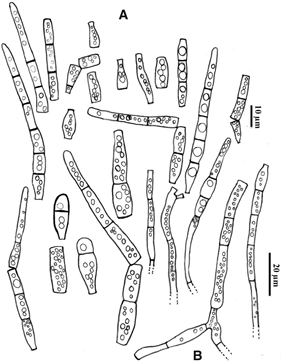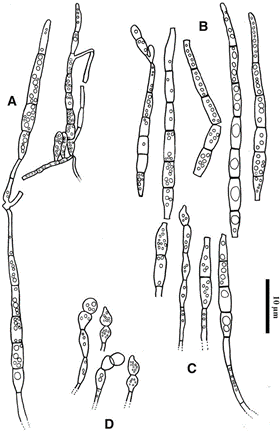Keqinzhangia aquatica Z.F. Yu, M. Qiao & R.F. Castan˜eda, sp. nov. (Figs. 2, 3, 4).
Etymology: Epithet refers to the collection from stream water.
MycoBank number: MB 840432; Index Fungorum number: IF 840432; Facesoffungi number: FoF 05739;
Asexual morph hyphomycetous. Colonies flat, growing slowly on CMA, attaining about 2.4 cm diam. after 20 days at 25 °C. Pale mouse grey, reverse mouse grey. Mycelium mostly immersed, composed of cylindrical, branched, densely micro-guttulate, septate, subhyaline to hyaline vegetative hyphae and cylindrical-obclavate, inflated and subulate at the tip, macroguttulate, dark septate, hyaline, smooth-walled fertile hyphae. Conidiophores prostrate, undifferentiated. Conidiogenous cells holothallic, narrowly cylindrical, frequently undifferentiated, hyaline, forming conidia by random thallic-arthric disarticulation. Conidia thallic-arthric, solitary, polymorphic, cylindrical-obclavate, long obclavate, cylindrical, bacilli- form, fusiform, narrow doliiform, subdolabriform, suboblecythiform or cuneiform, truncate at the ends or truncate at the base and obtuse or rounded at the apex, 0–6(-7)-septate, slightly or strongly constricted at the dark septa, sinuate, macroguttulate, smooth, hyaline, 12–76.5 × 3–6.2 lm, arising after random disarticulation of fertile hyphae at the darker septa. Clamydospores solitary or catenate, broad globose, subglobose to ellipsoidal, terminal, slightly or densely guttulate, smooth, subhyaline, 8–12.6 × 4.1–5.4 lm. Sexual state: Unknown.
Holotype: YMF 1.04262, isolated from leaves of an unidentified dicotyledonous plant submerged in a stream, E’mei National Conservation Area, Sichuan Province, China, 29°35’1″N, 103°17’3″E, ca. 1750 m elev., Jun 2014, Zefen Yu, permanently preserved in a metabolically inactive state (deep freezing) in the Conservation and Utilization of Bio-Resources in Yunnan. Ex-type culture CCTCC AF 2,021,070 = CGMCC 3.16100.
Notes: In Keqinzhangia aquatica, the fertile hyphae are located at the margin of the colony arise laterally from vegetative hyphae forming aerial mycelium with narrow cylindrical, cylindrical, long cylindrical-ob- clavate, obclavate, inflated or globose, subulate cellular structures, that include the tip growth. The thallic- arthric conidia are formed by random fission at the darker septa of preexisting cells of the fertile hyphae in a similar holothallic mode described by Cole (1986) and Seifert et al. (2011).

Fig. 2 Keqinzhangia aquatica (YMF 1.04262). a–c Conidia. d chamydospores. e Sections of the fertile hyphae. Scale: (a– e) = 10 lm

Fig. 3 Drawing of Keqinzhangia aquatica made by R.F. Castan˜eda-Ruiz. (a) Conidia. (b) Conidiogenous cells with attached and detached conidia after the thallic-arthric disarticulation

Fig. 4 Drawing of Keqinzhangia aquatica made by R.F. Castan˜eda-Ruiz. a Sections of fertile hyphae. b Conidia. c Conidiogenous cells and attached ‘‘conidia’’. d Chlamydospores
